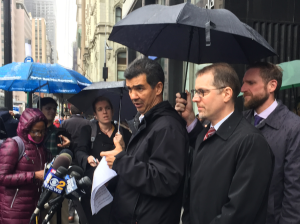DOT: Relax Brooklyn, Parking Permits Not Just for Downtown
Borough Prez Candidate De Blasio Qualifies His Opposition to Congestion Pricing
A crowd of nearly 200 filed into the auditorium at St. Francis College in downtown Brooklyn last night, ready to pop a few questions to DOT about residential parking programs. But first, three of Brooklyn’s City Council members gave some of their first public comments since the Congestion Mitigation Commission delivered its final recommendations last week.
David Yassky kept his speech short, pretty much sticking to the sentiment that RPP is good because it will "give neighborhood residents first crack at the parking spots on residential streets."
Tish James, who had previously expressed support for congestion pricing if RPP was attached, staked out the position that Fort Greene, Clinton Hill, and Prospect Heights — her district — should all be covered by RPP, regardless of what happens to pricing. (This foreshadowed a major theme of the evening — fear that one’s neighborhood would be left outside looking in when the RPP boundaries are drawn.) James then ran through her "wish list related to congestion pricing," which ranged far and wide, including: capital improvements to transit ("the G train sucks"), taxi stands, more bike lanes, ending placard abuse, and re-instating the commuter tax. It wasn’t exactly clear at the end where she now stands on pricing itself.
Bill de Blasio opened by saying, "I need to see complete, tangible, absolute progress on RPP before I can think of supporting congestion pricing." He then proposed that RPP zones should be allowed to sprout all over the city in neighborhoods near subway lines, to deter park-and-ride behavior. At one point he delivered some provocative rhetoric about weaning ourselves from the automobile, preparing for a different future, and changing our habits. But his verdict on pricing? "We don’t expect the current plan on the table to pass."
When DOT Deputy Commissioner Bruce Schaller and his team took the stage, they were somewhat on the defensive. A Windsor Terrace man (who later identified himself as the chair of Community Board 7) had accused the previous speaker, Joanne Simon of the Boerum Hill Association, of "drawing a line around her neighborhood." The offense: Simon had showed the audience a map of the 2004 downtown Brooklyn RPP study, which applied to Boerum Hill, Brooklyn Heights, and parts of Fort Greene.
So Schaller took pains say that RPP would be available to many neighborhoods on an opt-in basis. Though not every neighborhood would be eligible, Schaller reacted favorably to de Blasio’s idea of mapping RPP zones near subway lines. He recapped DOT’s recent neighborhood parking workshops and outlined the four basic RPP options DOT is currently weighing. In a straw poll at the end of the event, almost everyone in the audience, except for the Windsor Terrace contingent, said they wanted some form of RPP. The most popular variant was DOT’s Option A.
A few interesting nuggets came out of the Q & A session between the audience and Schaller’s team, though many questions were more interesting for the attitudes revealed than any information brought to light. Here are some highlights:
Q: When will there be a pilot program?
A: If congestion pricing goes according to plan, a test RPP program would go into effect prior to spring 2009.
Q: What political authorization is necessary to proceed with RPP?
A: The city can implement a temporary pilot on its own, but it needs state approval for a permanent RPP program.
Q: Will DOT hold forums in Sunset Park, Windsor Terrace, and other neighborhoods?
A: DOT wants to be in touch with neighborhoods and anticipates talking to different Community Boards about RPP.
Q: How will boundaries be determined?
A: DOT will look to community boards to help decide. The size of a zone should be reasonably compact, conforming to notions of what a neighborhood is (i.e. not just a few square blocks, but not half the borough either).
Q: Why give local employees permits at all?
A: One view is that they contribute to the local economy and should be accommodated, another is that they should take transit or park off-street like other non-residents. Some sort of balance based on the context of the neighborhood is probably desirable.
Q: Won’t the only stores that can withstand RPP be big boxes and those with big parking lots?
A: No, most people who shop at local merchants are already parking at meters, so RPP wouldn’t affect them. (That was the answer given; no one said anything about all the people who walk, bike, or take transit to shop and eat out.)
Q: What about people whose cars are registered outside the neighborhood in order to get cheaper car insurance — will they be eligible for permits?
A: There was no firm answer to this at first, then a consensus seemed to emerge that RPP permits should be based on where cars are registered, which would bring insurance cheats in line.
Q: What steps will be taken to ensure that permits are not loaned, stolen, or sold?
A: They will have the license plate or vehicle registration number on them.
